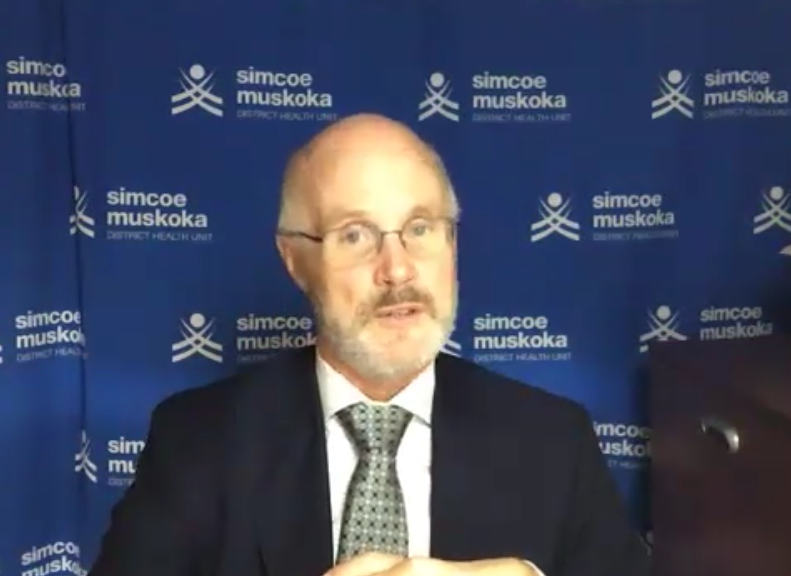As the Simcoe Muskoka region saw a record number of new COVID cases Wednesday, the province reverses direction on its reopening plans, and public health units struggle to keep up with an onslaught of new cases, the January pandemic outlook is bleak.
“We’re up against a force of nature, a powerful adversary … and it has taken the world’s resources to struggle with it and still we’re in this situation,” said Dr. Charles Gardner, medical officer of health for the Simcoe Muskoka District Health Unit.
The omicron variant is spreading at unprecedented rates, causing sharp spikes in cases with the peak of the fifth wave still unknown.
While some health experts predicted a 90 per cent vaccination coverage rate could bring herd immunity when delta was the dominant strain, the latest variant has a knack for bypassing the double doses, removing much of the protection against transmission for the vaccinated.
“We have taken major steps back,” said Gardner during a media briefing on Dec. 22. “I think it’s important to note where we still have strength … having the great majority of the population with two doses of vaccine is important. It puts people within the range of getting that third dose and it still provides probably in the range of 70 per cent protection against hospital admission.”
The protection level against hospitalization was much higher (high 90s) with two doses of vaccine against the delta variant.
"We put a lot of faith in vaccination and we're very, very disappointed with omicron and the degree to which it has undermined the effectiveness of the vaccines," said Gardner.
According to Gardner, two doses of an mRNA vaccine is protective in the range of about 30 per cent for the prevention of transmission (becoming a COVID case).
"We still have quite a bit of benefit from a third dose," said Gardner.
The takeaway, said Gardner, is to get a booster, and use rapid and PCR testing to identify cases.
However, his advice could be frustrating for most in Simcoe-Muskoka who cannot find a rapid test for free or for purchase, and who have to wait two months or more for a booster dose appointment since the current slots are booked.
“I recognize fully the challenge of this situation and certainly encourage people to continue to look for and book access to vaccinations,” said Gardner. “It’s very worrisome and I can certainly and acknowledge the concerns that people have at this time.”
The doctor said the health unit and its partners in the vaccination roll out are committed to expediting the third dose campaign in a way that is sustainable, similar to the mass immunization that took place in the summer.
Currently, appointments at the community vaccine clinics across the region are nearly or entirely booked up for the next two months. Free rapid tests promised by the province via local LCBO stores were snatched up within the first couple of hours.
Meanwhile, cases surge Ontario-wide, and most health units across the province are prioritizing limited contact tracing resources for high-risk settings, asking members of the community to reach out to their own close contacts if they test positive, and take responsibility for their own self-isolation.
Outbreaks are going undeclared because of a lack of resources to investigate clusters of cases.
Testing numbers are already showing a per cent positivity in the region nearing seven per cent, and the province reported a rate of over 10 per cent. Per cent positivity refers to the number of people who test positive compared to the number of tests processed. The provincial standard indicates this rate should be at or below three per cent in order to ensure enough people are being tested to catch the majority of COVID cases. Percentages above three indicate COVID cases going undetected.
“Access to testing is going to become increasingly compromised as case counts elevate going forward,” said Gardner.
Those who develop symptoms and/or are a contact of a possible case, he said, should get tested if they can, and if not, they still need to isolate.
“You need to take it upon yourself to do all the other precautions to the very best of your ability: physical distancing and mask use – a good quality mask – really reduce your social circle at this time, and practice hand sanitization and self-monitoring,” said Gardner.
“It’s tough, there’s no doubt about it,” said Gardner. “The projections from the science table were very worrisome … the one projection they had that involved some degree of control to buy us time for vaccination required a 50 per cent reduction in people’s social contacts. That’s very hard to achieve.”
The doctor reiterated his commendations from last week over the province-wide capacity limit reduction put in place by the provincial government.
“But that might not achieve that degree of reduction of contacts, and we need to see the degree to which it actually blunts transmission,” said Gardner.
For information on booking vaccine doses, how to pick high-quality masks, and finding a testing centre, visit the health unit website here.



